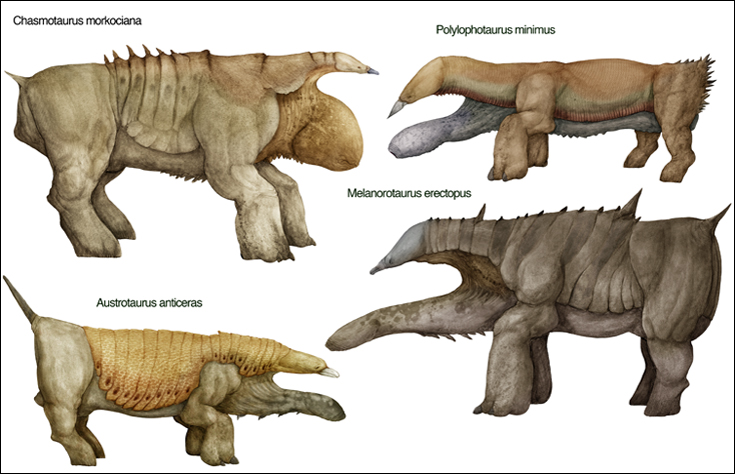Allotauriformes
These hulking, armored animals dominate the large herbivore niches on the mainland continents. A familiar sight to many Snaiadi citizens, the Allotauriformes are among the most speciose lineages of advanced herbivores on the planet. Allotauriformes are united through the presence of extremely well developed, churning second head mouths, bands of hardened skin folds that form a protective armor and unique rear legs with digits and distal bones fused into a semi-flexible, boot-like appendages. In addition, most species also sport horns or spikes on their rear ends, possibly as a defense against Fututor attacks.
Allotauriformes are tentatively divided into two major groups; the Archaeotaurids; which have relatively larger front legs and larger, less efficient second heads, and the Hesperotaurids, which have a more “regular” gait and compact, efficient feeding heads. These two groups seemed quite distinct in the past, but recent fossil discoveries and molecular studies might reveal them to be polyphyletic.
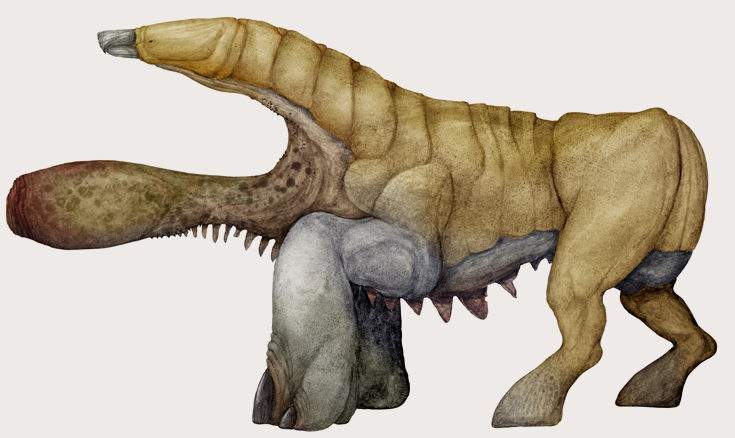
Species: Allotaurus chrysolophus
Common Name: Golden Bull.
Size: Up to 5 meters long.
Habitat: Grassy and regular sproglands across northern parts of Isterna and Vesterna.
It is an unusual coincidence that the first observed and the most widely known member of the Allotauriformes is in fact a very aberrant member of the group. Famous for the bright, golden coloration of its leathery armor plates, this species has its forequarters and second head exaggerated to ungainly proportions. Its huge, vat-like second head is a voracious feeding apparatus; able to rip patches sprog all the way down to the naked ground. To support the weight of this massive organ, the front legs are huge and tractor-like. These powerful limbs are also used in self-defense; a hulking stomp from one of them can easily crush even the most powerful Snaiadi predators like grapes.
In between seasons, this species joins many of its cousins in the massive megaherbivore migrations from Isterna to Vesterna and back. These migrations are accompanied by a variety of predators, commensal species and parasites.
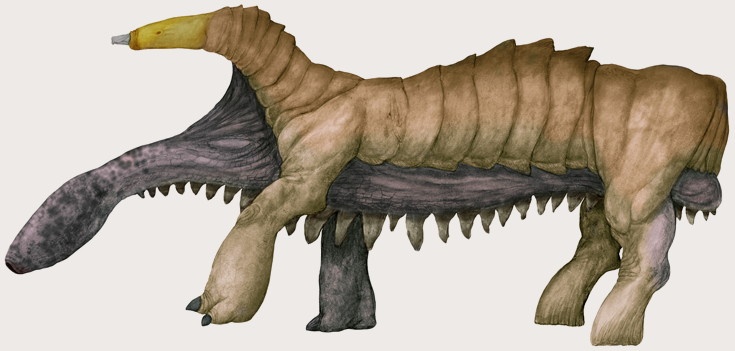
Species: Barotaurus longus
Common Names: Kadilak, Limotaur, Behemoth.
Size: Up to 11 meters long.
Habitat: Edges of jungles and wet forests across northern Vesterna
This gigantic animal is the longest, if not the heaviest of all known Allotauriformes. A placid herbivore, it grazes along riverbanks and edges of gallery forests and even pinnacle ranges, preferring a mixture of bushy red and green plants instead of sprog. It has an enormously extended second-head neck that is supported by the suspension bridge-like arrangement of its first head. In this respect Barotaurus (independently) resembles the extraordinary Titaniformes of far-away Thalassia. Although this gigantic animal has no trouble supporting itself on dry land, occasionally it is seen wallowing in deep rivers, or even the sea. Due to the uncomfortable location of its breathing orifices beneath its armpits, it is usually forced to make barrel rolls in order to breathe under water. This ponderous, but also weirdly graceful aquatic ballet also seems to form a part of the animals’ mating rituals, but only in the warmer seasons.
B. longus is the only member of its genus. This animal very similar in most respects to the three species of Allotaurus, and until recently it was classified as Allotaurus titanis. Unlike its Allotaur cousins, Barotaurus does not migrate or form herds. Its huge size is sufficient to protect it from most predators. (However, they are vulnerable as young - the individual pictured here has healed gouges on its flank, battle scars from a past attack by an unknown Fututoriform.) An even larger animal, thought to be related to Barotaurus, reportedly lives in the Great Azonic Jungle on the other side of Vesterna.
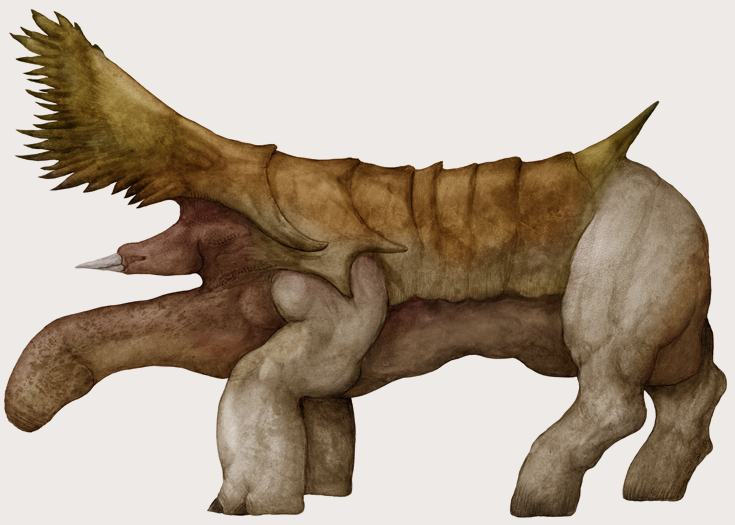
Species: Teratodirus aspersa
Common Names: Shingleback, Fanhorn.
Size: Up to 4 meters long, usually less.
Habitat: Mostly around Pansavannah, a minority population migrates between Pansavannah and northern Isterna.
One of the more unusual Allotaurs, this species has the folds of its leathery plates hardened into six sideways-projecting spikes, and a bizarre, saw-toothed crest that projects forward from the top of its first head. Its defenses are further supplemented by a backwards-pointing horn on its rear, a countermeasure against attacking Fututors. While the rear and side spikes are the same in most individuals, the head crest is tremendously variable; some individuals hardly seem to have it at all while in others it grows to a grotesque size that seems like a hindrance to the animal. Both sexes have crests, but only the males carry the record-breaking ones.
This is a relatively small Allotaur that dwells in family herds up to ten individuals large. Mature males usually break away from established herds to find mates on their own. Paradoxically, certain “feminine” males in these groups have very small crests, or no crests at all. These individuals have been observed “sneaking in” to other family herds and discreetly mating with the females before running away.

Species: Chasmotaurus morkociana
Common Names: Musclemouth, Muskullu, Zat.
Size: Up to 7 meters long.
Habitat: Forests and jungles all across Isterna. Absent from the Ankyranian Desert and Oroland.
This enormous animal is markedly different from all other Allotauriformes, so some Snaiadi zoologists classify it in its own group. Instead of the long neck and the vat-like grazing organ of other Allotaurs, Chasmotaurus has an enormously thick, muscular, shortened mouth, much like those of the Xenosuids. Its diet is also different from other Allotauriformes in that it contains, in addition to rough and indigestible vegetation of all sorts, helpings of scavenged meat. On a single occasion, a Chasmotaurus has been observed trampling a defenseless loplophid (Bandia borealis,) and consuming parts of its dead body. In the big picture of Allotaur evolution, this animal seems to be a deviation from the usual Allotauriform pattern of herding herbivores, into a more omnivorous, solitary lifestyle.
Although widespread, Chasmotaurus has a very diffuse population, with a small number of animals spread across a large territory. Their rarity, combined with these animals’ unnatural aggression towards trespassers of any sort, makes them notoriously hard to study.
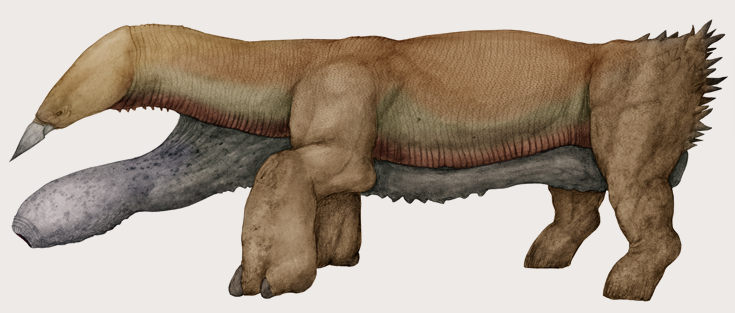
Species: Polylophotaurus minimus
Common Names: Tinytaur, Spiny Allotaur, Dwarf Allotaur.
Size: 1.6 meters long.
Habitat: Jungles, pinnacle ranges, forests and scrublands across South-Western Vesterna.
Not all Allotauriformes are giants. This western form is among the smallest members of a five-species sub-clade known as the Suitaurs, or pig-bulls. Living in burrows constructed by their spade-like first-head beaks, these animals emerge during the day to forage. Their preference is for soft-tissued wetland plants or fruiting bodies, but these generalists are perfectly comfortable feeding on other plants as well. When danger threatens they quickly retreat to their burrows, blocking the entrance with their spiny hindquarters.
These tiny Allotaurs are noteworthy for having a large number of armored skin-folds across their backs. This is reflected in their genus name – “Polylophotaurus” means “many-ridged-bull.”
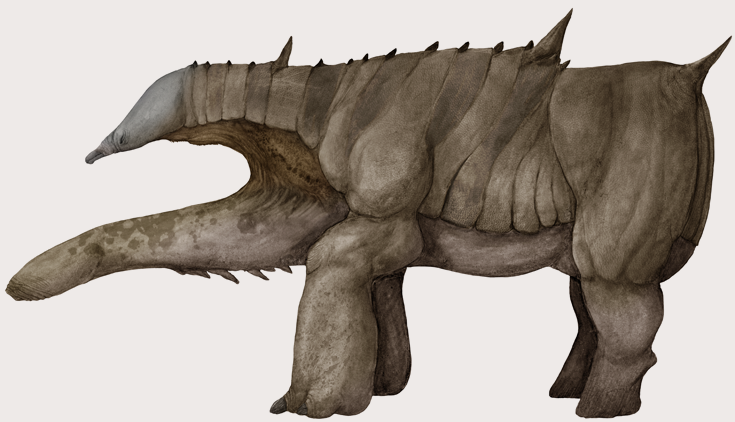
Species: Melanorotaurus erectopus
Common Names: Black bull, Apis.
Size: Up to 6 meters long, usually less.
Habitat: Sprogland habitats across most of Vesterna.
This is a fairly typical “Hesperotaur,” if the outdated term still holds any meaning. Much like their cousins in Isterna or Pansavannah, these large herbivores roam across the sproglands and plains of their realm in big herds, eating copiously and continuously. Their elongated second heads make it possible for these animals to tackle both sprog and tree-growing vegetation. Unusually among Allotauriformes, these animals sometimes engage in “pinnacle probing,” crashing the sides of pinnacle-tree reefs in local ranges, and feeding on the vegetation inside. Three large spines on their neck, back and rear ensure that no predators inside or outside the pinnacle threaten them.
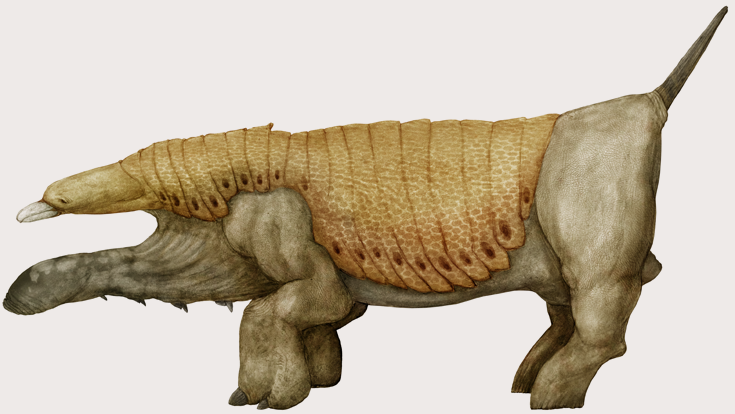
Species: Austrotaurus anticeras
Common Name: Spinotaur.
Size: 4 – 4,5 meters long in the mainland, 2 meters or less in the Midland.
Habitat: Sproglands and forests in Midland, also present in south western Isterna.
This unusual little Allotaur is readily identifiable through its brightly colored dorsal armor and the extraordinarily long “anti-Fututor horn” that grows from its rear. This horn grows throughout the animals’ lives and is frequently broken off and regrown as the animals go through near-escapes and accidents. Other than warding off predators, the rear horn also seems to play a social role; mating couples have been observed clashing them together in ritualistic combat. In the jungles of south western Isterna, individuals bang them across hollow trees to signal each other across the misty darkness.
Two distinct populations of this species exist on south western Isterna and Midland. It is uncertain whether the dwarf population in Midland was already there before the land bridge to the main continents was submerged, or if they somehow swam or rafted over later on. In any case, the Midland population might be classified as a separate species as more studies are undertaken.
Copyright laws protect all intellectual property associated with Snaiad.
All artwork, concepts and names associated with this project belong to C. M. Kosemen, unless otherwise stated.

